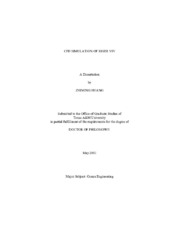| dc.description.abstract | The dissertation presents a CFD approach for 3D simulation of long risers. Long riser VIV simulation is at the frontier of the CFD research area due to its high demand on computational resources and techniques. It also has broad practical application potentials, especially in the oil and gas industry. In this dissertation, I used a time domain simulation program - Finite-Analytic Navier-Stokes (FANS) code to achieve the 3D simulations of riser VIV. First, I developed a riser modal motion solver and a direct integration solver to calculate riser dynamic motions when subject to external forces. The direct integration solver provides good flexibility on inclusion of riser bending stiffness and structural damping coefficients. I also developed a static catenary riser solver based on trial and error iteration technique, which allowed the motion solvers to handle catenary risers and jumpers with arbitrary mass distribution. I then integrated the riser motion solvers to the existing FANS code, and applied the CFD approach to a series of riser VIV problems including a 2D fixed/vibrating riser, a 3D vertical riser in uniform and shear currents, a 3D horizontal riser in uniform and shear current, a hypothetic 3,000 ft marine top tensioned riser in uniform current, a practical 1,100m flexible catenary riser in uniform current, and a hypothetic 265m flexible jumper partially submerged in uniform current. I developed a VIV induced fatigue calculation module based on rain flow counting technique and S-N curve method. I also developed a modal extraction module based on the least squares method. The VIV details, including flow field vorticities, rms a/D, riser motion trajectories, PSDs, modal components, VIV induced stress characteristics, and VIV induced fatigue damages were studied and compared to the published experimental data and results calculated using other commercial software tools. I concluded that the CFD approach is valid for VIV simulations in 3D. I found that the long riser VIV response shows complex behaviors, which suggests further investigation on the lock-in phenomenon, high harmonics response, and sensitivity to the lateral deflections. | en |


